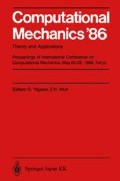Summary
Nine-node quadrilateral element (HP-9) and twelve-node quadrilateral element (HP-12) are formulated on the basis of Reissner-Mindlin plate bending theory by the assumed-stress type hybrid method. Both are free from spurious kinematic mode and not leading to “locking” phenomenon in thin plate limit. Numerical examples demonstrate improvement in stress and displacement performances when comparing with existing counterparts.
Access this chapter
Tax calculation will be finalised at checkout
Purchases are for personal use only
Preview
Unable to display preview. Download preview PDF.
References
Pian, T.H.H.: Derivation of element stiffness matrices by assumed stress distributions. AIAA J. 2 (1964) 1333–1336.
Pian, T.H.H.: Constraints for stresses in hybrid plate and shell elements. Finite element methods for nonlinear problems. Europe--US Symposium, Trondheim, Norway, Aug. 12–16, 1985.
Lee, S.W. and Pian, T.H.H.: Improvement of plate and shell finite element by mixed formulations. AIAA J. 16 (1978) 29–34.
Spilker, R.L. et al: The hybrid-stress model for thin plates. IJNME, 15 (1980) 1239–1260.
Pan, Y.S.: Master thesis, Southwestern Jiaotong University, Emei, China, (1984–1985).
Zhao, Z.: Master thesis, SWJTU, Emei, China, (1984–1985).
Pian, T.H.H. and Chen, D.P.: On the suppression of zero energy deformation modes. IJNME, 19 (1983) 1741–1752.
Pugh, E.D. et al: A study of quadrilateral plate bending elements with “reduced integration”. IJNME, 12, No.7, (1978).
Washizu, K.: Variational method in elastisity and plasticity. Pergamon Press, 3rd Edition, 1982.
Reissner, E.: The effect of transverse-shear deformation on bending of elastic plates. JAM, 12, No.2, June 1945, 69–77.
Cook, R.D.: Concepts and applications of finite element analysis. 2nd Edition, John Wiley & Sons, New York, 1981.
Spilker, R.L. et al: A serendipity cubic-displacement hybrid stress element for thin and moderately thick plates. IJNME, 15 (1980) 1261–1278.
Author information
Authors and Affiliations
Editor information
Editors and Affiliations
Rights and permissions
Copyright information
© 1986 Springer Japan
About this paper
Cite this paper
Chen, D.P., Pan, Y.S. (1986). Formulation of Reissner-Mindlin Moderately-Thick/Thin Plate Bending Elements. In: Yagawa, G., Atluri, S.N. (eds) Computational Mechanics ’86. Springer, Tokyo. https://doi.org/10.1007/978-4-431-68042-0_2
Download citation
DOI: https://doi.org/10.1007/978-4-431-68042-0_2
Publisher Name: Springer, Tokyo
Print ISBN: 978-4-431-68044-4
Online ISBN: 978-4-431-68042-0
eBook Packages: Springer Book Archive

